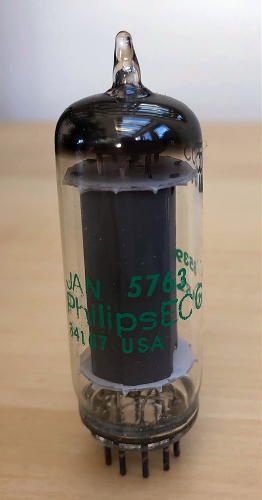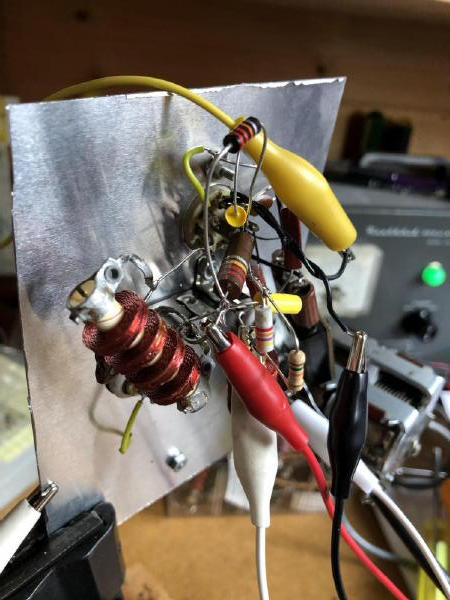

My recently constructed 1-tube Neophyte regen receiver turned out to be a much better performer than anticipated. I soon decided that it really deserved to have a matching transmitter which could be paired-up to make a complete but simple station! I visualized a cold rainy winter being spent in the cozy radio shack, challenging myself to work (and confirm) all 50 U.S. states using just the tiny regen and a matching one-tube transmitter.
The circuit I sought would require the transmitter to use a miniature tube in order to physically match the regen in appearance. After searching out various possible transmitter circuits, I finally decided on one originally published by W6NJV back in the 60s and described on W9BRD's wonderful website, Enjoying Radio. Dave's website is a treasure trove of information on regens, simple transmitters, oscillators, tube lore and ham radio nostalgia. I find myself often going to this site for building inspiration. If you haven't visited Dave's site, you're missing out ... there is much wisdom to be found within its pages!
The W6NJV 5763 crystal power oscillator described on Dave's page fit the bill perfectly and the project was soon underway.
The 5763 is a 9-pin miniature beam power tetrode power amplifier that was originally developed in the late 40's for use in low power mobile application on HF and VHF. It was commonly used in driver / multiplier stages as well as in oscillators.

It seemed that the described circuit should readily supply enough RF (7-8W) to allow some transcontinental work on both 80 and 40m CW and I liked the more modern pi-network output as it would be a refreshing change from my usual tuned link-coupled output one-tube transmitters. My initial concern was that the small chassis restrictions might not provide room for the rather large loading capacitor needed in the pi- network. After quickly sketching out a parts placement plan and measuring the loading capacitor's size, it seemed like everything might just fit!
The circuit is not particularly unique and is eerily similar to several one-tube designs from the 50s and 60s such as Ameco's famous AC-1. Most however, don't use a tube as ideal as the 5763. The 7-pin miniature tube is not only a good RF oscillator but its physical size would provide me the matching Neophyte appearance I was looking for.A forage through my junk box revealed that all the necessary parts were on hand and once gathered, the circuit was breadboarded on an aluminum sheet test bed. The test bed, something that is done with all projects, allows part values to be optimized and circuits parameters to be measured before final assembly.
It performed well, keying like a dream on any crystal that was tried ... even the tiny HC-49 style crystals keyed without damage but they did chirp when tested at full power ... however, my only two 5763s were not in great shape and initially provided lower output than expected. I was fortunate to find a nearby tube supplier that had listed a box of five NOS JAN5763s at a price too good to pass up.
The new ones produced even more output than expected. Was it because of their heftier military-grade construction? I would expect JAN tubes might be physically more rugged but I wonder if their operating specs are also beefed-up?
Before dissasembling, a few 40m contacts were made, with clip leads and parts dangling from the vise-held plate, further testament to the 'magic' of radio!

Some small changes were made to optimize the circuit. The screen resistor (R2) was changed from 22K to 14.5K which still kept the screen current within rated value. The grid leak resistor (R1) was dropped from 47K to 6.8K following the advice found on Dave Newkirk's page re the advantages to be had with a smaller than 'usual' grid leak ... if you have an AC-1 or a clone, try this as well. The loading capacitor was increased from the specified 365pfd to 800pfd.With 400 VDC on the plate, the transmitter produces 12-13 watts output on 40m (depending on crystal activity) into a 50 ohm load. Measured screen current is 11 ma. with a screen voltage of 260 VDC. With a DC plate input power of ~23W, the efficiency is ~ 55%. The 365pfd loading capacitor specified in the original article is not enough to properly match to a 50 ohm antenna on either 80m or 40m, a common problem with many pi-network rigs. Even with the two-sections of my dual 400pfd loading capacitor paralleled, the range was not sufficient for 80m, but fine on 40. An extra phono jack was mounted beside the antenna output jack to plug in an additional fixed (mica) capacitance of 1600pfd to increase the pi-network's matching capability when on 80m.
The coil specified in the original article was found to be too large. I cut the B & W Miniductor down to 12.6uH which covers both 80 and 40m perfectly with my 240pfd plate capacitor.
For more information about the W6JNV circuit, visit W9BRD's Celebrating the One-Tube Oscillator Transmitter page.
Like the Neophyte regen, the companion transmitter worked even better than expected, producing more power and better keying characteristics than I had originally hoped for. Several stations have commented on the nice keying and that it didn't sound like most one-tube power oscillators. The circuit seems to put little stress on precious crystals yet still produces useful output power. The two units make a compact and capable little station.
The final outcome turned-out as initially visualized and the transmitter, along with the one-tube Neophyte regen, have been in daily use on 40m. My usual frequency is 7120 kHz while 7113 kHz is secondary when QRM is not a problem. I'm using a 40m 'half-sloper' for the antenna system.
Since the transmitter is crystal-controlled, almost all of my contacts have come from stations replying to my CQs.
After two months of near daily afternoon operation, on January 22, 2021, the little pair completed Worked All States on 40m CW. Also worked has been VE9, VE1, VY1, VE3, VE6 and VE7.
Some of the Neo-twin's cards are still arriving and are shown below. I've yet to put the duo to work on 80m but will do so shortly.
If you're looking for a simple yet effective one-tube transmitter, the 'Neophyte Companion' might be just what you need.
PS - I have now completed W.A.S. on 80m using the Neophyte pair only. All fifty of the 80m cards are shown below. Thanks to all of you with such great ears!


